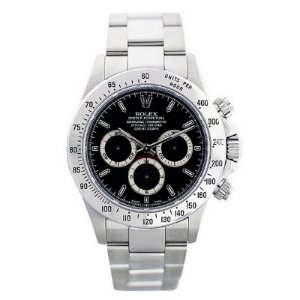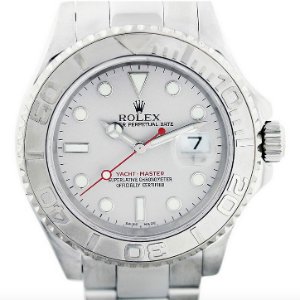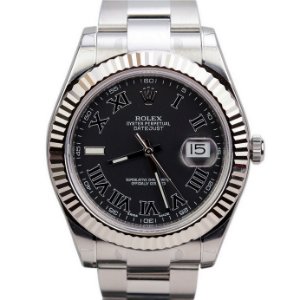Which Rolex is Which: Guide to Rolex Watch Styles
Rolex is perhaps the most well-known watch brand in the world. The Swiss watchmaker regularly (albeit infrequently) debuts new models that nearly instantly become fan-favorites and as iconic as their predecessors. We look at the history of Rolex’s five most popular watch models.
5. Rolex Daytona

The Rolex Daytona was introduced in 1963. The design was inspired by racecar drivers and auto-enthusiasts and actor and IndyCar driver Paul Newman in particular. Newman is the namesake for the rare Rolex Daytona “Paul Newman” dial which features subtle design differences—like block markers instead of lines and seconds sub-dials at 15, 30, 45, and 60—often overlooked by the uninitiated. Newman wore his Rolex Daytona every day for 36 years until his death in 2008.
If you’re in the market for a new Rolex Daytona, expect to join a waiting list that has, at times, been eight years long. Rolex Daytona watches hailing from 1961 through 1987 (reference numbers 6238, 6239, 6240, 6241, 6262, 6263, 6264, and 6265) are incredibly rare and, in turn, highly prized by watch collectors. The high demand for a Rolex Daytona—new or pre-owned—means it retains—if not triples in—its resale value. To wit, Christie’s held an auction in Geneva of 50 Rolex Daytona watches and they collectively garnered over $13 million USD.
4. Rolex GMT-Master II

Launched in 1954, the Rolex GMT-Master II was designed in collaboration with Pan American Airways. Pilots and airline crews used Greenwich Mean Time (GMT) as the international time standard so their flight records, plans and schedules referenced this universal clock. In turn, Rolex designed the GMT-Master II which featured a 24-hour display and a rotating 24-hour scale bezel to help pilots quickly read the GMT or a second time zone. First produced only in stainless steel, the Rolex GMT-Master was intended to be a real “work horse” watch and featured a Cerachrom bezel which is even more scratch-resistant than steel.
Modern Rolex enthusiasts are fond of the GMT with a blue and red bezel, dubbed the “Pepsi Bezel” which was re-released in 2014. The Rolex GMT-Master II has also matured from its practical origins and is now offered in precious metals like gold and some more ornate designs feature precious stones. While these luxury GMT-Master watches may have a higher price tag, stainless steel vintage models are the savvy collector’s favorite—should they be lucky enough to find one!
3. Rolex Yacht-Master

Introduced in 1992, the Rolex Yacht-Master is a comparative newcomer to the list. The Rolex Yacht-Master shares a lot of design and technical similarities with the Rolex Submariner but, given that it was made in 18Kgold, was meant to be a luxurious alternative to the Submariner. In 1999, Rolex released the Yacht-Master in Rolesium, a Rolex-exclusive material made of stainless steel and platinum.
The Rolex Yacht-Master II was introduced in 2007. Despite sharing a name with its predecessor, the Yacht-Master II has a very different aesthetic, namely a massive 44 mm case. The Yacht-Master II also has a special time-lapse bezel which, in keeping with the watch’s nautical theme, is meant to be used as a regatta timer. (Yacht skippers use a regatta timer to signal when their boat can cross the starting line.)
2. Rolex Datejust II

The Rolex Oyster Perpetual Datejust (or Rolex Datejust) was a big-time “first” for Rolex and the greater horology industry. The Rolex Datejust was the first certified, self-winding chronometer watch manufactured by Rolex in 1945. It was also the first watch to include an automatically changing date function. (While we may take that date display for granted today, it was an incredible innovation in watch complications at the time.) In 1954, Rolex updated its Datejust with the date-manifying “Cyclops Lens” that has since become a hallmark of Rolex watches.
1. Submariner

Although Rolex had already produced water-resistant watches, the Submariner was the brand’s declaration that it was breaking into the diving-watch market. The Rolex Submariner underwent a handful of rigorous field tests, conducted by the Institute for Deap Sea Research in Cannes, to prove its credibility as a professional diver’s watch. A Submariner predecessor was affixed to the front of August Piccard’s bathysphere (a spherical deep-sea submersible) in 1953. The vessel dove to 10,275 feet and surfaced with the prominently displayed Rolex in perfect working order. Championed by Rolex founder Hans Wildsorf and René-Paul Jeanneret, an experienced diver and Rolex board member, the Rolex Submariner design included a rotating bezel for divers to quickly read the remaining time of their dive.
And in 1954, the Rolex Submariner officially debuted at the Basel Watch Fair. Soon after, the Rolex Submariner was the watch of choice for the British Royal Navy (1955) and Royal Canadian Navy (1956).
Since its introduction, the Rolex Submariner’s design has been largely unchanged. The watch’s striking look is functional, professional and elegant.







